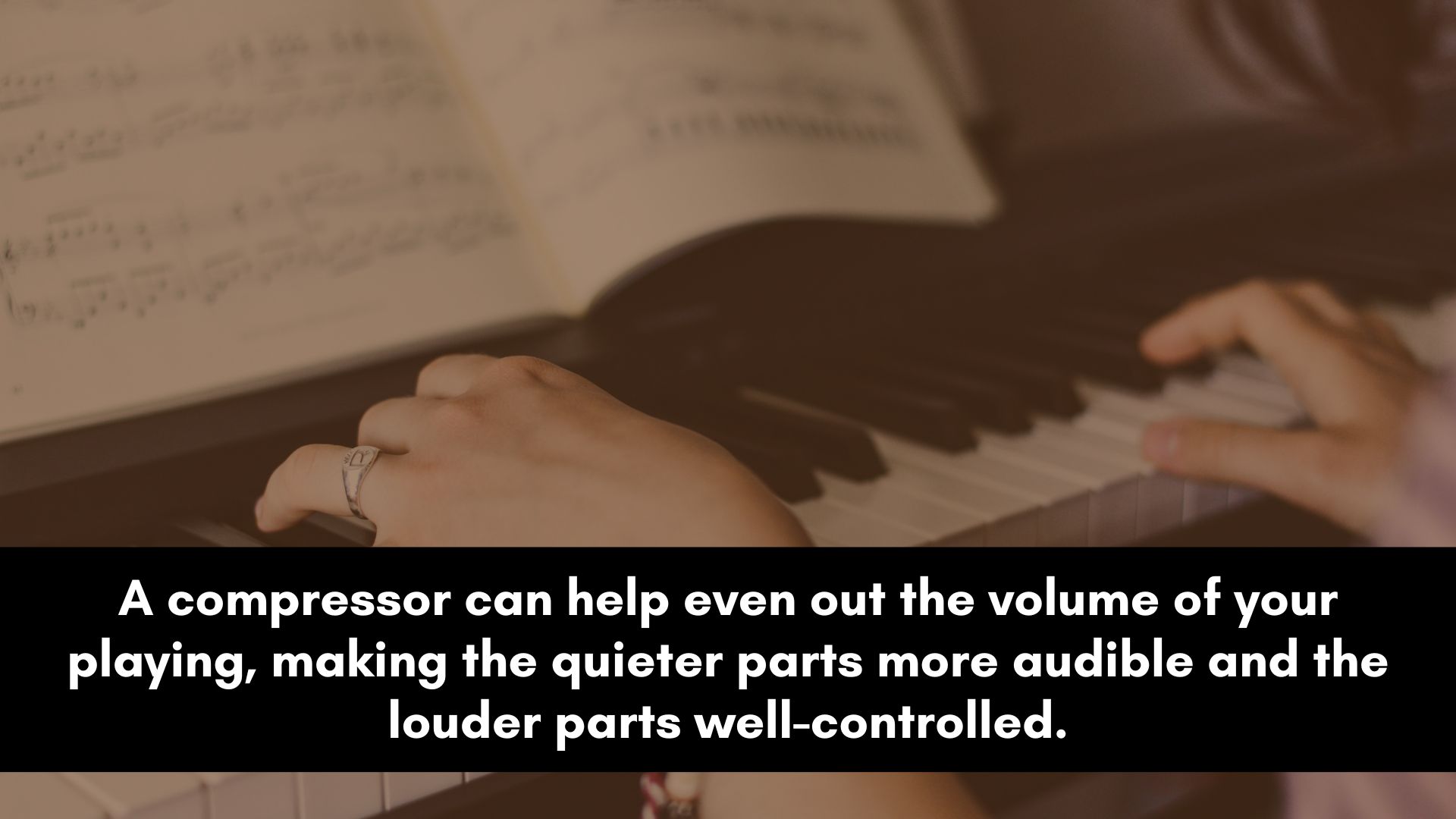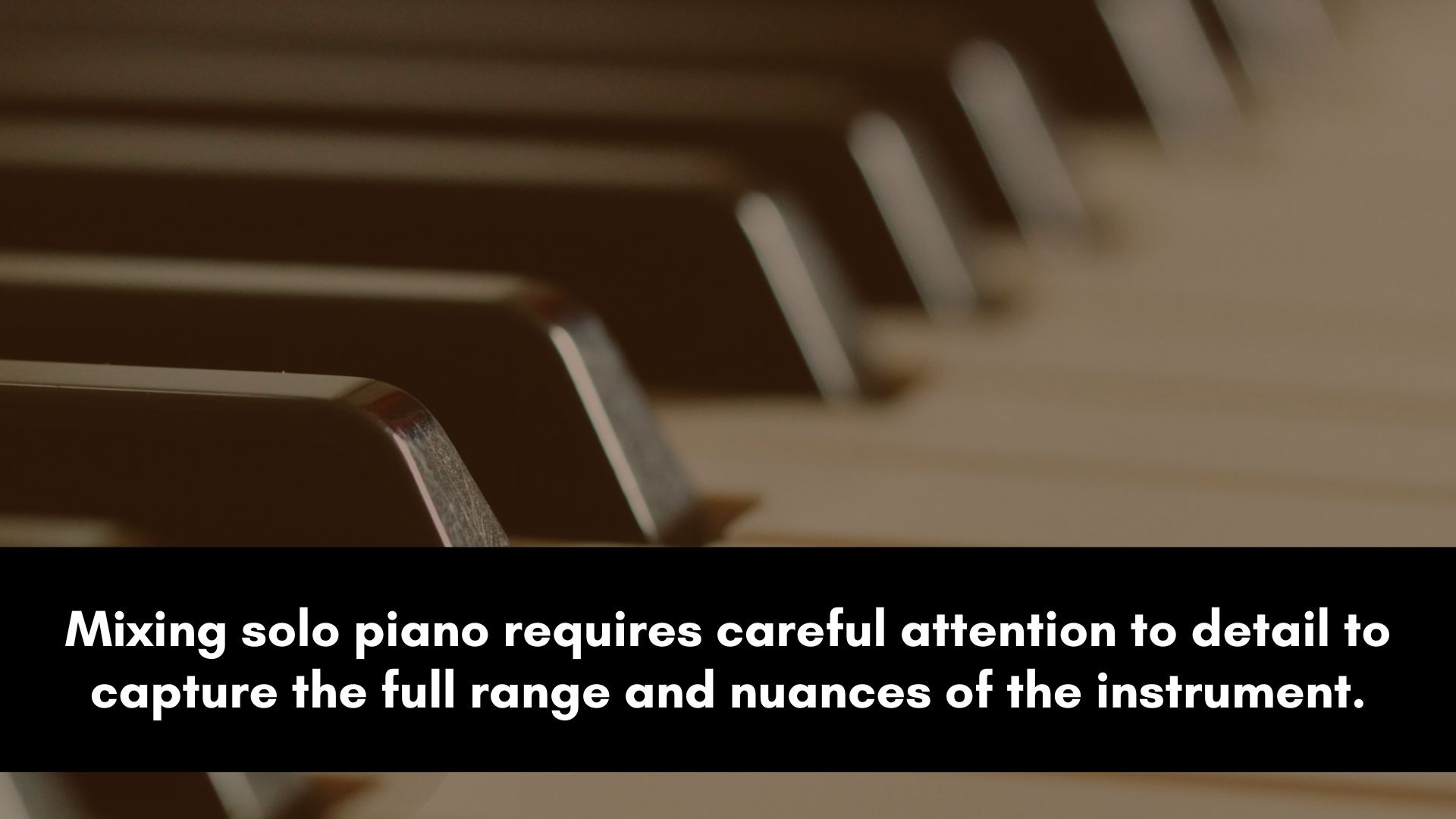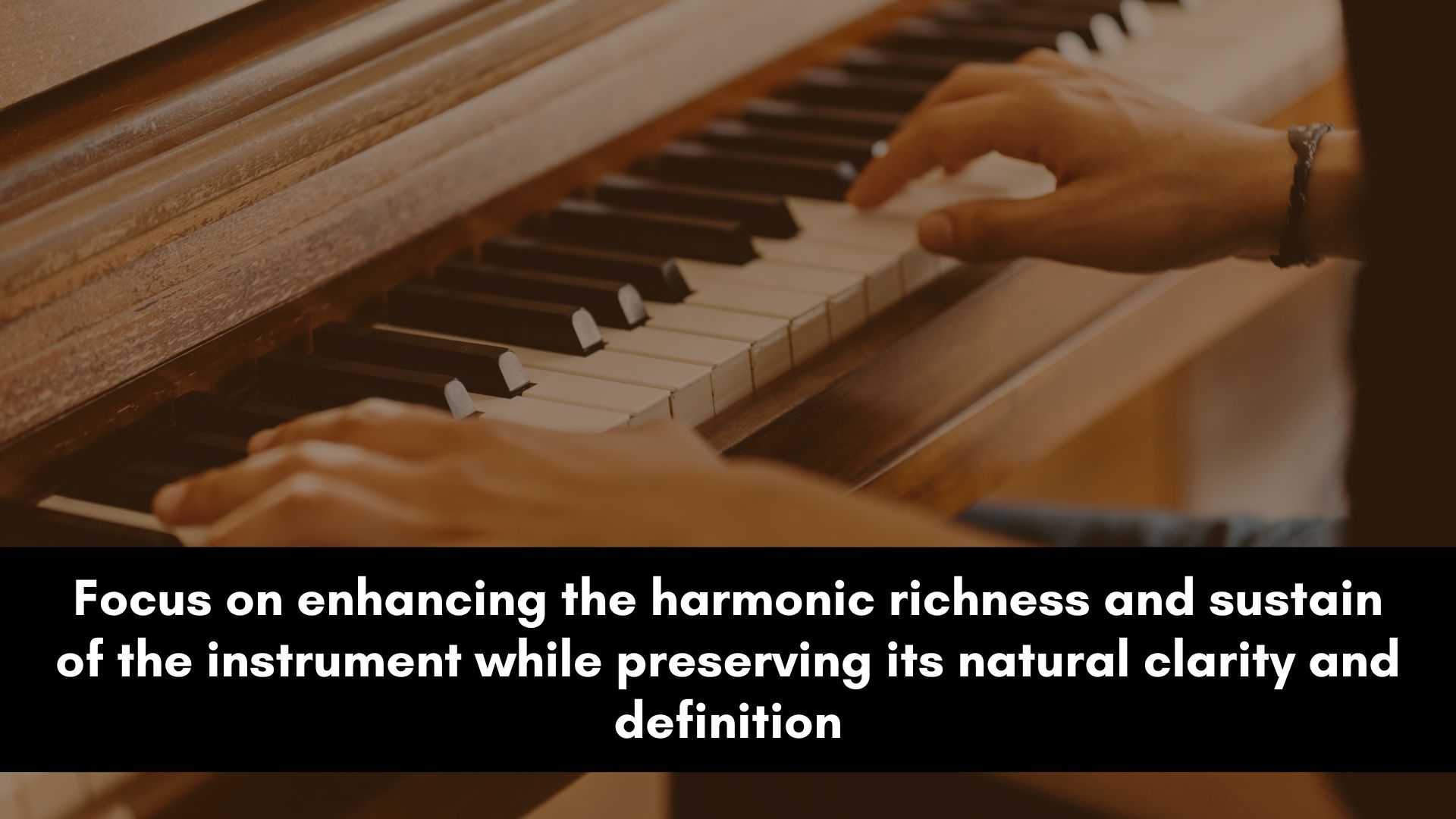As one of the most beloved and versatile instruments in the world, the piano is often at the heart of countless musical compositions.
Whether you're working on a classical symphony, a pop ballad, or a jazz improvisation, a well-mixed piano can be the key to unlocking the emotion and impact of your music.
In today’s tutorial, we'll explore some tips and techniques for mixing piano to help you get the most out of this timeless instrument.
How to Mix Piano
Before you even begin mixing, it's essential to have a good recording of your piano performance.
Whether you're using a microphone to capture an acoustic piano, recording a digital piano, or using a VST instrument, make sure you’re working on a clean, clear sound that captures the nuances of your playing.
It’s crucial to get the right sound from the source instead of trying to fix poor recording or bad sound design issues during mixing.
Once you have a great piano sound, you can focus on enhancing it so that it fits perfectly with other sounds in the mix.
How to EQ Your Piano
One of the most important aspects of mixing piano is getting the EQ right.
The frequencies of a piano cover a wide range, from the low-end of the bass strings to the top end.
Depending on the genre of music you're working with, you may want to emphasize or de-emphasize certain frequencies to achieve the desired sound.
For example, in a classical piece, you may want to boost the mid-range frequencies to bring out the warmth and richness of the piano's tone, while in a pop or rock song, you may want to cut some of the lower mids to prevent the piano from competing with the bass and drums.
You can learn more about equalizing a piano in my previous post “How to EQ Piano.”
Piano Compression Techniques

Compression is a powerful tool for controlling the dynamics of your piano performance.
A compressor can help even out the volume of your playing, making the quieter parts more audible and the louder parts well-controlled.
However, it's important to use compression wisely and not overdo it, as too much compression can result in a lifeless, unnatural sound.
The key is to get a good balance between keeping the level and tone consistent without changing the timbre or character of the piano.
I wrote a complete tutorial about this topic; check out “How to Compress Piano” to get a detailed guide.
Apply Reverb for Space & Depth

Reverb is a key ingredient in creating a sense of space and dimensionality in your mix.
Adding a touch of reverb to a piano can help it sit better in the mix, give it a sense of depth, and create contrast with other sounds.
However, like compression, it's important not to overdo it. Too much reverb can make the sound muddy and push it to the back of the mix.
A hall reverb often works well if the piano is playing a supporting role. When applying reverb to a solo piano, you might want to use a plate to keep it upfront.
Room and chamber reverbs are great if you want to make the piano sound warm and thicker.
Experiment with different reverb types to give the piano its own sound.
Consider Stereo Width
It's important to consider the stereo width of your piano.
Depending on the role it’s playing in the mix, your piano may be panned hard left and right or placed in the center of the stereo field.
If the piano is playing sustained chords, usually it will remain in the center. This way, it can translate well in mono and when played on different sound devices.
It’s important to keep it centered because if it’s playing sustained chords, this means it’s part of the core instruments of the song.
However, you may want to use stereo imaging plugins to adjust the perceived width of the piano, making it sound wider or narrower as needed.
This will create a bit of space between the other sounds that are centered. These could be the lead vocal, kick, bass, snare, etc.
If the piano is percussive or playing a melody, you can experiment with different panning settings to find the right balance for it in the mix.
There’s no correct or wrong way to pan the piano; you have to do what works best for the mix.
Learn more about this in my previous post, “How to Pan Different Instruments.”
FAQ About Mixing Piano
Before concluding the tutorial, it’s important to answer some commonly asked questions about mixing piano.
These are questions that I used to ask myself when I was starting out.
If there’s anything I missed, then please post it in the comments below so that I can add it to this guide.
How to Mix Solo Piano?

Mixing solo piano can be a challenging task, as it requires careful attention to detail to capture the full range and nuances of the instrument.
Here are some tips for mixing solo piano:
- As with any mixing project, it's essential to start with a good recording, sound design, or samples. Whether you're recording an acoustic piano or a digital keyboard, make sure that the recording captures the full range and dynamics of the instrument.
- Solo piano covers a wide frequency range, from the deep bass notes to the sparkling high notes. Use EQ to accentuate the desirable frequencies and cut out any unwanted frequencies.
- Compression can be a useful tool when mixing solo piano. Use a gentle ratio, such as 2:1 or 3:1, low gain reduction, and a slow attack and release time to preserve the natural dynamics.
- Reverb can help to add ambiance and depth. A shorter reverb time can help to create a more intimate sound, while a longer reverb can add a sense of spaciousness.
- Also, consider the stereo imaging of the instrument. Use stereo imaging plugins to create a sense of depth and dimensionality for the solo piano.
By using EQ, compression, reverb, and stereo imaging, you can create a compelling and impactful mix that showcases the beauty and potential of the sound.
Mixing Piano and Guitar
Mixing piano and guitar can be tricky, as they both occupy a similar frequency range and can clash with each other.
To help you solve this issue, I’ve put together a few tips that will help you create space for each sound in a mix.
Create Separation With EQ
One of the most important tools for creating separation is to use EQ.
This means cutting out frequencies that the other instrument is occupying so that they don't overlap and create a muddy or cluttered sound.
For example, if you boost the piano at 2.5 kHz, you may want to cut the guitar in that area and maybe boost the guitar around 1 kHz, then cut the piano at that frequency.
Note that the numbers are just for example purposes.
Panning & Stereo Imaging
Panning the piano and guitar can also help to create separation.
By panning the two instruments to opposite sides of the stereo field, you can give them their own space in the mix and prevent them from competing with each other.
However, you should know that when the mix is played in mono, those two sounds will still clash. This is why it’s better to separate them with EQ rather than relying on panning alone.
Hence, I recommend using panning along with stereo imaging tools (or techniques).
Using this approach will put each sound in its own space, even when the mix is played in mono.
Use Reverb to Create Space
Reverb can help to create a sense of space and depth in your mix, which can also help to separate the piano and guitar.
By using different types of reverb and settings for each instrument, you can create a sense of distance between them and make them sound more distinct.
For example, you may want to use a longer, more spacious reverb for the piano and a shorter, tighter reverb for the guitar.
Arrange the Parts Differently
Another way to prevent clashes between the piano and guitar is to arrange their parts in a way that they complement each other.
This means avoiding playing the same chords or melodies at the same time and instead finding ways to complement each other's parts.
For example, the piano could play a chord progression while the guitar plays a melody or riff over the top.
Use Automation
Finally, using automation can help to create dynamics and variation in your mix, which can also help to prevent clashes between the piano and guitar.
By automating the levels and EQ of each instrument at different points in the song, you can create a sense of movement and interest that keeps the listener engaged.
How to Mix Piano and Vocals
Mixing piano and vocals can be a delicate and nuanced process, as both instruments are essential elements in many genres of music.
Here are some tips for mixing piano and vocals in a mix:
EQ to Create Separation
In the case of piano and vocals, it's important to use EQ to ensure that the two instruments aren't competing for the same frequencies.
You may want to cut some of the mid-range frequencies from the piano to make room for the vocals.
For instance, vocals usually dominate the high midrange around 2 kHz. If the piano is clashing with the vocals you may want to reduce 2-4 kHz on the piano.
You can compensate by boosting around 900 Hz to 1.5 kHz on the piano. Again, these numbers are not accurate; they’re just examples.
Use Compression for Contrast & Depth
Compression can be used to separate the piano and vocals.
For instance, you can use a fast attack on the piano and a medium-to-slow attack on the vocals. This will usually push the piano behind the vocal.
You can even take it a step further by using a high ratio and gain reduction on the piano.
So, play around with the compressor parameters to put each sound in its own space in the mix.
Use Reverb to Create Depth
Manipulate reverb to push the piano behind the vocal. You can achieve this by using a short reverb on the vocal and a long one for the piano.
Longer reverbs such as halls tend to push sounds towards the back of a mix, while something like a plate will keep a sound upfront.
Experiment with different reverb types to create contrast and give each sound its own space.
Balance the Levels
Balancing the levels of the piano and vocals is key to creating a cohesive and balanced mix.
The vocals are often the most prominent element in the mix, with the piano supporting them in the background.
Play around with different levels until you find the right balance for both sounds.
How Can I Make My Piano Sound Fuller?

To make a piano sound fuller, you need to focus on enhancing the harmonic richness and sustain of the instrument while preserving its natural clarity and definition.
Here are some techniques that you can try:
The source: The key is to get the right sound straight from the source. So you want to use great samples or proper recording techniques instead of relying too much on mixing.
Use reverb or delay: Add reverbs such as room and chamber. These kinds of reverb add thickness to the lower midrange frequencies.
Using a delay with short feedback and a long delay time can also create a sense of reflection and sustain. This often adds warmth and makes the piano sound fuller.
Apply light compression: Applying a gentle and transparent compressor to the piano can also help to enhance the sustain and decay of the notes by reducing the dynamic range and bringing out the higher-level details. Use a higher ratio and a slower attack time to capture the full envelope of the piano.
Utilize EQ to shape the tone: Boosting the low frequencies around 100–200 Hz can help add some warmth and body to the piano. Be careful not to boost too much, as it can make the piano sound boomy or clash with low-end instruments.
Layer with other instruments: Layering the piano with other instruments can create a sense of harmony and texture that can make the piano sound fuller and richer.
Use a pad, a string section, or a choir to fill in the gaps and complement the piano's timbre and dynamics. Be careful not to overdo the layering, as it can make the piano sound cluttered or indistinct.
Saturating the piano: adding something like tape or tube saturation can also increase the fullness of the piano and add extra harmonic content.
These are just some of the techniques that you can use to make your piano sound fuller.
Keep in mind that every piano is different and that the best way to achieve the desired fullness is to experiment with different settings and combinations.
It’s crucial to listen to the results in the context of the mix to make sure that what you’re doing compliments the song.